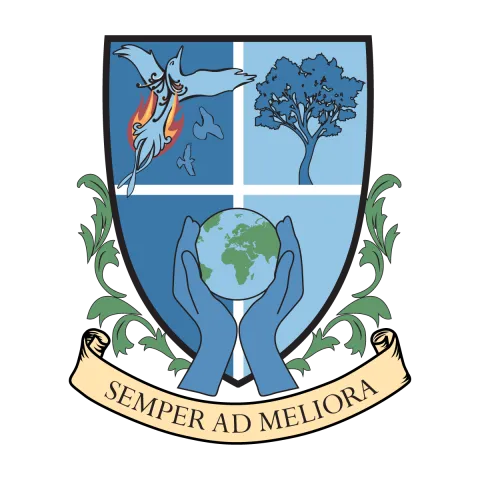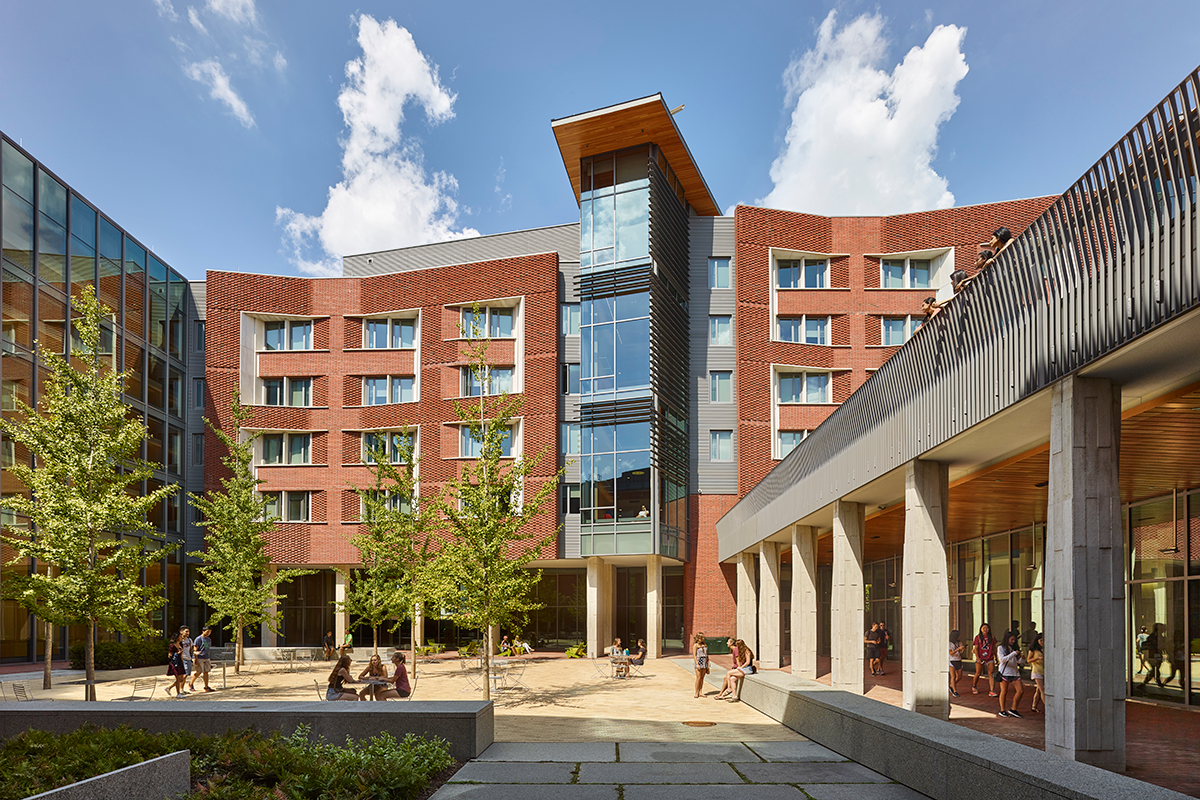Lauder College House is located in the northeastern corner of Penn’s campus, on the expansive and historic Hill Field. It carries LEED Silver Certification from the U.S. Green Building Council, meaning that we take our sustainability seriously! From our Green Roof to our Courtyard, which functions as a sponge to slowly return rainwater to the ground and the nearby Schuylkill River, we’re invested as a community in actions big and small that can have a positive impact on our environment. Over the course of the year, we’ll also, of course, use our courtyard as a gathering space for social events, group or personal study—or just taking in the rays. And in the winter, you can sit by a cozy fire in our Living Room and watch the Philadelphia sleet and snow through the window.
Crest and Motto

New College House unveiled its crest during Spring 2017. The Traditions Commission, led by residents Morgan Thweatt, Nyazia Bey, Jerome Cohen, and RAGA staff members Elaida Dimwamwa, Kevin Chen, Tyler Hallmark, and Haley Morin, facilitated a multi-stage process for engaging the house community in creating the crest. They collaborated with Chris Bogs, Marketing Coordinator for College Houses & Academic Services to host a design workshop for residents, created design criteria, and collected submissions from residents. The Traditions Commission hosted a gallery-style event in January 2017 where all house residents were invited to vote for the design.
Resident Jad Blaik designed the winning crest; his creation was selected by popular vote out of 11 submissions.
Jad’s design represents our college house as a global village. The hands holding the earth stand for our varied community. Coupled with the image of the tree, the crest shows our commitment to sustainability. The phoenix, our house mascot, is also represented in the crest. The design also features the house colors, blue and white, and our motto, “Semper ad meliora (Always onward to better things)” is proudly displayed on a banner at the bottom border.
The crest continues to represent the ideals of the house community through its renaming to Lauder College House in 2019. During the naming ceremony, the crest was featured on the banner that was unveiled revealing the name, as well as on commemorative t-shirts, mugs, and cookies given to attendees.
Motto
The motto of LCH is "semper ad meliora," or "always onward toward better things."
During Fall 2016, the Traditions Commission hosted conversations about what residents believe it means to be part of the LCH community. They called for residents to submit suggestions for statements that capture the LCH experience and hosted an online poll to select the motto. Residents voted to select "semper ad meliora" to signify a desire to continously grow and develop, both as individuals and as a house community.
History
A New College House on Hill Field
Cam Grey, Faculty Director
The building that we call home sweeps in a reverse J-shape from the corner of 33rd and Chestnut Streets in the northeast, around a gently sloping grassy space that culminates in a lifted lawn overlooking a courtyard, to finish in the middle of Hill Field. A south-facing entrance and glass-encased Dining Pavilion greet both commuters on their way to or from 30th Street Station and our neighbors in Hill College House, which sits just on the other side of Woodland Walk. The building was designed by Bohlin Cywinski Jackson, and constructed by INTECH Construction.
The official ground-breaking for then-named New College House occurred on Friday, November 8, 2014, attended by Penn Trustee Chair David L. Cohen, President Amy Gutmann, representatives of the Lauder Foundation and other major donors, and many members of Penn’s community. But this triangular sliver of ground has been involved in the university’s history since the 1870s, when Penn first relocated to West Philadelphia. At that time, it housed a series of rowhouses, but in the early 1890s Philadelphia city developer Adolph Segal placed an eight-storey apartment building designed by William H. Free on the entire block. Soon afterwards, this building (initially called the Bartram Apartment House) was transformed into a luxurious longstay hotel, named the Bartram Hotel.
The building underwent a series of major renovations in the 1920s and 1930s, and by the 1940s had become part of the Milner Hotel chain. In the late 1950s, it was torn down, as part of preparations for the construction of a collection of buildings including a women’s Residence Hall on the block of land bordered to the south and north by Walnut and Chestnut Streets, and to the east and west by 33rd and 34th Streets. The women’s Residence Hall, now called Hill College House, was designed by Saarinen & Associates and completed in 1965. Plans for another Residence Hall, to be located on the site where our building now sits, were drawn up by Ken Roche (who carried on Eero Saarinen’s firm after his death in 1961), but this project was never brought to completion.
For the next 40 years, Hill Field would host informal and semi-formal recreation activities for members of the Penn community. Early in the new millennium, it witnessed the celebration of 125 Years of Women at Penn and in 2003, Jenny Holzer’s sculpture project, 125 Years was opened. This curving walkway of text-based sculptured benches and path borders runs the length of Woodland Walk, and is adjacent not only to Hill College House (now fully co-educational), but also to Bennett Hall, the location of Penn’s College for Women before its merger with the Graduate School of Arts and Sciences, the College of Arts and Sciences [for Men], and four social science departments in the Wharton School to form the new School of Arts and Sciences in 1975. The history of women at Penn is, literally, all around us!
In 2005, Hill Field witnessed the construction of the McNeil Center for Early American Studies, designed by Robert A. M. Stern Architects, which sits on the northeastern extension of Woodland Walk and overlooks our bicycle racks and front entrance. The Center facilitates the study of the history, societies, and cultures of North America and the Atlantic World before 1850, through fellowships and funding at the pre- and postdoctoral levels, as well as seminars and conferences. As a consequence, we need only take a short walk to begin upon the process of situating the history of our building and the University of Pennsylvania within a broader, deeper context.
The specific history of our building begins in the mid-2000s as well, when discussions about the development of a twelfth College House began in earnest under the leadership of President Amy Gutmann. After initial investigation of the feasibility of constructing a building across the street from Hill Field, the decision was made instead to build on our current location. This decision was accompanied by a commitment to preserving the bulk of the open green space that has long been the hallmark of Hill Field, and to observing the tenets of Penn’s Climate Action Plan 2.0. As a consequence, our building carries an LEED Silver Certification from the U.S. Green Building Council.
In August, 2016, New College House welcomed 344 members of the Class of 2020 to be its first community, and the first Penn students to call this building home. Together, they worked, lived, and played, and in the process created a culture and traditions that will infuse this physical space and serve as a foundation for future generations to build on.
In September, 2019, at a celebration commemorating the first cohort of four-year residents, Penn President Dr. Amy Gutmann and members of the Lauder family unveiled the House's permanent name: Lauder College House. Lauder will continue to shine as an example of the communities Penn's students can create now and in the future.
Special Thanks to:
David Brownlee
Marty Redman
University Archives
